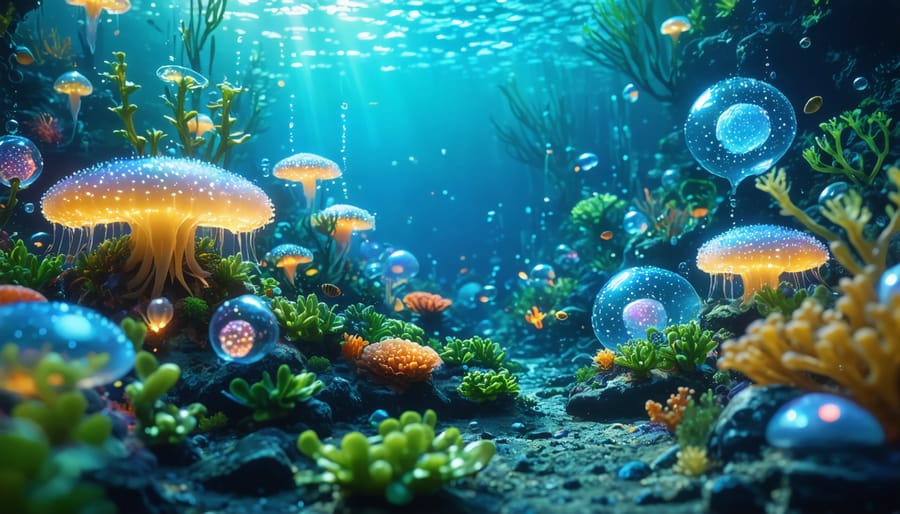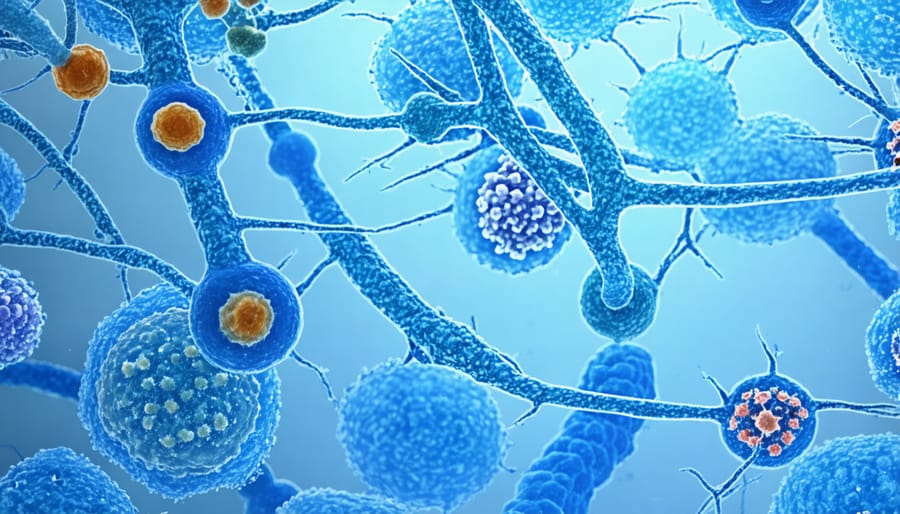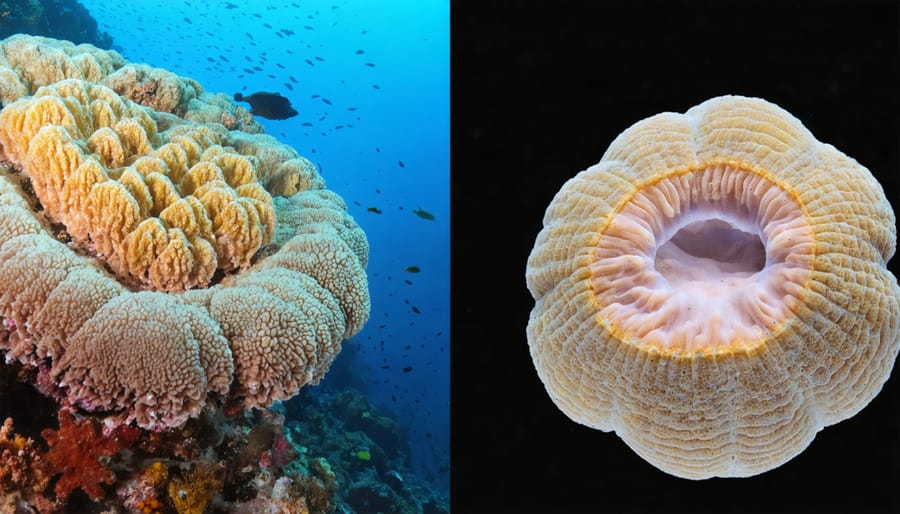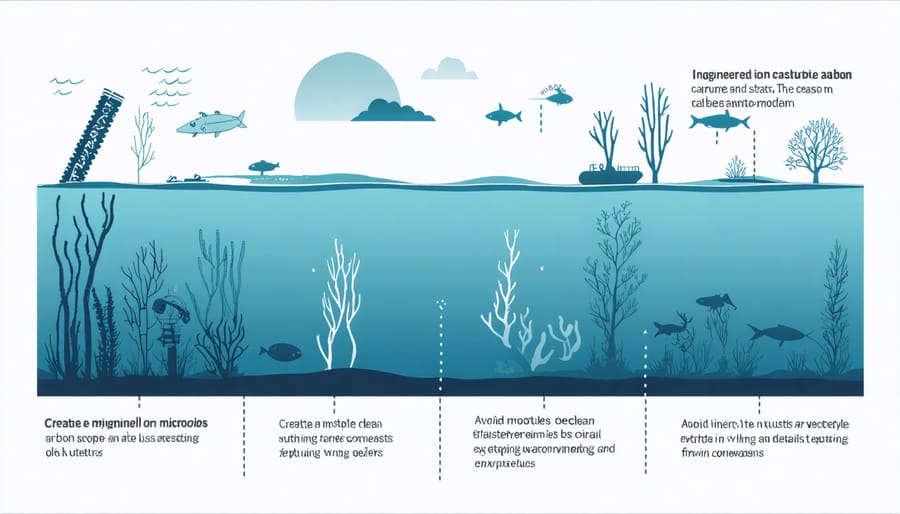
Beneath the ocean’s surface, a microscopic revolution is unfolding. These tiny marine organisms – numbering in the billions per liter of seawater – hold the key to understanding and potentially reversing the damage in our dying marine ecosystems. Ocean microbes, from bacteria to microscopic algae, form the foundation of marine life, producing half of Earth’s oxygen and driving the planet’s most crucial biochemical cycles.
Recent discoveries have revealed these microscopic powerhouses possess remarkable abilities to adapt, restore, and regenerate marine environments. They break down pollutants, sequester carbon dioxide, and provide essential nutrients to larger marine species. More importantly, scientists are now harnessing these natural capabilities to develop innovative solutions for ocean restoration, from oil spill cleanup to coral reef rehabilitation.
As we face unprecedented challenges in ocean conservation, these invisible allies offer hope. Their rapid reproduction rates, genetic diversity, and metabolic versatility make them ideal partners in our efforts to protect and restore marine environments. Understanding and working with ocean microbes may prove to be our most powerful tool in preserving the health of our blue planet for future generations.
The Hidden World of Marine Microbes

Key Players in Ocean Health
Several key microbial species play vital roles in maintaining ocean health and ecosystem balance. Prochlorococcus, the world’s smallest photosynthetic organism, produces up to 20% of Earth’s oxygen and forms the foundation of many marine food webs. This tiny powerhouse demonstrates how even microscopic life forms can have global impacts.
Marine Synechococcus, another crucial photosynthetic bacterium, complements Prochlorococcus by thriving in different ocean zones and contributing significantly to primary production. Together, these microorganisms form a photosynthetic partnership that sustains countless marine species.
Nitrogen-fixing bacteria, such as Trichodesmium, convert atmospheric nitrogen into forms that other organisms can use. These bacteria essentially fertilize the oceans naturally, supporting the growth of phytoplankton and larger marine life. Meanwhile, archaeal species like Nitrosopumilus maritimus play a crucial role in the nitrogen cycle by oxidizing ammonia, helping maintain proper nutrient balance in marine ecosystems.
Vibrio fischeri, famous for its bioluminescent properties, exemplifies the complex relationships between microbes and larger marine organisms. This species forms symbiotic relationships with various marine animals, including the Hawaiian bobtail squid, highlighting the intricate connections within marine ecosystems.
These microorganisms, though invisible to the naked eye, form the backbone of ocean health and demonstrate nature’s remarkable ability to maintain balance through microscopic workers.
Nature’s Ocean Engineers
In the vast oceanic realm, microbes serve as nature’s tireless engineers, orchestrating crucial processes that maintain the delicate balance of marine ecosystems. These microscopic organisms work around the clock, recycling nutrients, breaking down organic matter, and supporting the foundation of marine food webs.
At the heart of their engineering prowess lies the carbon cycle. Marine microbes process nearly half of Earth’s carbon dioxide, converting it into organic matter through photosynthesis. Species like Prochlorococcus, though tiny, produce an estimated 20% of the world’s oxygen, demonstrating how these invisible workers significantly impact global atmospheric conditions.
Nitrogen-fixing bacteria perform another vital engineering role, converting atmospheric nitrogen into forms that other marine life can use. This process is essential for coral reefs, where these microbes provide necessary nutrients to both corals and their symbiotic algae. Meanwhile, archaeal microbes near hydrothermal vents transform sulfur compounds, creating energy that supports entire deep-sea communities.
Marine microbes also act as nature’s cleanup crew, breaking down pollutants and dead organic matter. When whales or other large marine animals die and sink to the ocean floor, specialized microbial communities quickly colonize these “whale falls,” efficiently recycling the nutrients back into the marine ecosystem.
Understanding these natural engineers helps scientists develop better strategies for ocean conservation and restoration, as healthy microbial communities are essential indicators of marine ecosystem health.
Engineering Microbes for Marine Restoration
Coral Reef Recovery
Innovative approaches to rebuilding coral reef ecosystems have revealed the remarkable potential of engineered microbes in marine restoration. Scientists have discovered that certain bacterial strains can enhance coral resilience and promote recovery in damaged reef systems.
These beneficial microbes work through multiple mechanisms. Some produce protective biofilms that shield coral tissues from environmental stressors, while others help regulate temperature sensitivity and reduce coral bleaching. Particularly promising are probiotic bacteria that can be introduced to reef systems to boost coral immunity and growth rates.
Dr. Sarah Chen, a marine biologist at the Pacific Reef Institute, has witnessed remarkable success using engineered microbes in controlled studies. “We’ve seen a 60% increase in coral survival rates when treating damaged reefs with specialized bacterial communities,” she explains. These microbes help corals adapt to warming waters and combat disease outbreaks that have devastated reef systems worldwide.
The process involves carefully selecting and cultivating beneficial bacterial strains in laboratory conditions, then introducing them to damaged reef areas through innovative delivery systems. These might include biodegradable carriers or direct application during coral transplantation efforts.
Community-based restoration projects have begun incorporating microbial treatments into their toolkit, offering hope for coral reef conservation. Volunteer divers and citizen scientists can now participate in monitoring these restoration efforts, contributing to our understanding of how engineered microbes perform in real-world conditions.

Pollution Management
Ocean microbes are emerging as powerful allies in the fight against marine pollution, offering innovative solutions for cleaning up contaminated waters. These microscopic organisms have evolved remarkable abilities to break down various pollutants, from oil spills to plastic waste, making them valuable tools in environmental restoration efforts.
Scientists have discovered specific bacterial strains that can metabolize hydrocarbons, effectively breaking down oil into less harmful compounds. These natural cleanup crews were notably active during major oil spills, where they helped accelerate the natural degradation process. Researchers are now working to enhance these capabilities through careful selection and cultivation of the most effective strains.
In recent developments, marine microbiologists have identified bacteria capable of breaking down microplastics, offering hope for addressing one of our oceans’ most persistent pollutants. When combined with eco-friendly marine restoration materials, these microbes can create more sustainable cleanup solutions.
Some species of marine bacteria also show promise in removing heavy metals and other toxic compounds from water. Through a process called bioremediation, these microorganisms can either transform hazardous substances into harmless compounds or accumulate them in their cells for easier removal from the marine environment.
While these microbial solutions offer great promise, researchers emphasize the importance of using them as part of a comprehensive approach to marine conservation, combining pollution prevention with active cleanup efforts.
Carbon Capture Heroes
In the quest to combat climate change, scientists are exploring innovative approaches using engineered marine microbes as powerful allies in carbon capture. These microscopic heroes are being modified to enhance their natural carbon-sequestering abilities, offering promising solutions for reducing atmospheric CO2 levels.
Research teams worldwide are developing specialized strains of photosynthetic microalgae and cyanobacteria that can absorb carbon dioxide more efficiently than their wild counterparts. These enhanced microorganisms can store carbon in their biomass or convert it into calcium carbonate, effectively locking it away in the ocean’s depths.
One groundbreaking project involves engineering diatoms – single-celled algae with glass-like shells – to absorb more carbon dioxide while producing stronger shells that sink more readily to the ocean floor. This process, known as the biological carbon pump, helps sequester carbon for centuries or even millennia.
Other initiatives focus on creating symbiotic relationships between engineered microbes and coral reefs, where the microorganisms provide additional protection against acidification while capturing excess carbon. These innovations not only help in carbon sequestration but also support the preservation of marine ecosystems.
While still in development, these bio-engineered solutions show remarkable potential. Early trials suggest that strategically deployed engineered microbes could sequester significant amounts of carbon while requiring minimal resource input, making them a sustainable tool in our climate action arsenal.

Challenges and Future Prospects
Safety and Environmental Concerns
While ocean microbes play vital roles in marine ecosystems, their manipulation and study require careful consideration of safety protocols and environmental impacts. Scientists must ensure that research activities don’t disrupt natural microbial communities or introduce harmful elements into marine environments.
Laboratory work with marine microbes follows strict biosafety guidelines to prevent the accidental release of modified organisms. Researchers use specialized containment facilities and sterilization procedures to maintain separation between experimental and natural populations. This is particularly crucial when studying potentially pathogenic microbes or those with enhanced metabolic capabilities.
Environmental monitoring is essential when conducting in-situ studies. Scientists regularly assess water quality parameters, microbial population dynamics, and ecosystem health indicators to detect any unintended consequences. This includes watching for unusual algal blooms, changes in local species distribution, or shifts in chemical composition of the water.
Climate change poses additional challenges, as warming oceans and changing chemistry affect microbial behavior and distribution. Researchers must consider these factors when developing conservation strategies and conducting experiments. Some microbes may become more prevalent or aggressive under new conditions, potentially affecting marine food webs and biochemical cycles.
The scientific community emphasizes sustainable practices in marine microbial research. This includes using non-invasive sampling techniques, minimizing plastic waste during fieldwork, and ensuring that research vessels follow environmental protection protocols. Through careful planning and adherence to safety guidelines, scientists can study these crucial organisms while preserving the delicate balance of marine ecosystems.
Next-Generation Solutions
Cutting-edge research in marine microbiology is revolutionizing our approach to ocean conservation. Scientists are developing sophisticated biosensors that utilize bioluminescent microbes to monitor water quality and detect pollutants in real-time. These innovative tools provide immediate feedback on ecosystem health, allowing for rapid response to environmental threats.
Genetic sequencing technologies have opened new frontiers in understanding microbial communities. By mapping the ocean’s microbiome, researchers can identify beneficial strains that could enhance marine ecosystem restoration. This knowledge has led to breakthroughs in laboratory coral restoration techniques, where specific bacterial communities are being cultivated to boost coral reef resilience.
Artificial intelligence and machine learning are now being employed to predict microbial responses to environmental changes, helping scientists develop proactive conservation strategies. These technologies analyze vast datasets of microbial behavior patterns, enabling more accurate forecasting of ecosystem shifts.
Perhaps most promising is the development of engineered probiotics for marine environments. These carefully selected beneficial microbes can help degraded ecosystems recover more quickly, break down pollutants, and strengthen the natural defense mechanisms of various marine species.
Looking ahead, researchers are exploring the potential of synthetic biology to create specialized microbial communities that could help combat ocean acidification and restore balance to damaged marine ecosystems. These innovations represent a new chapter in marine conservation, where microscopic allies become powerful tools for healing our oceans.
The potential of microbial engineering in marine ecosystem restoration represents a beacon of hope for our troubled oceans. By harnessing the power of these microscopic organisms, we can accelerate the recovery of damaged coral reefs, restore balance to polluted waters, and strengthen marine ecosystems against future challenges. The success of pilot programs using engineered microbes to break down plastic pollution and restore coral reef communities demonstrates that this approach is not just theoretical but practically achievable.
However, the implementation of microbial engineering solutions requires careful consideration and continued research. We must ensure that our interventions support rather than disrupt natural marine processes. This calls for increased funding for marine microbiology research, stronger collaboration between scientific institutions, and greater public awareness of the crucial role microbes play in ocean health.
You can contribute to this important work in several ways. Consider supporting marine research organizations, participating in citizen science projects that monitor ocean health, or joining local beach cleanup initiatives. Educational institutions can incorporate marine microbiology into their curriculum to inspire the next generation of ocean scientists. Businesses can invest in sustainable practices and support research into microbial solutions for marine conservation.
The future of our oceans depends on our ability to work with nature’s smallest inhabitants. Through responsible development of microbial engineering techniques and collective action, we can help restore and protect marine ecosystems for generations to come. The time to act is now, and every contribution counts in this vital mission to save our seas.
jessica
Ava Singh is an environmental writer and marine sustainability advocate with a deep commitment to protecting the world's oceans and coastal communities. With a background in environmental policy and a passion for storytelling, Ava brings complex topics to life through clear, engaging content that educates and empowers readers. At the Marine Biodiversity & Sustainability Learning Center, Ava focuses on sharing impactful stories about community engagement, policy innovations, and conservation strategies. Her writing bridges the gap between science and the public, encouraging people to take part in preserving marine biodiversity. When she’s not writing, Ava collaborates with local initiatives to promote eco-conscious living and sustainable development, ensuring her work makes a difference both on the page and in the real world.
